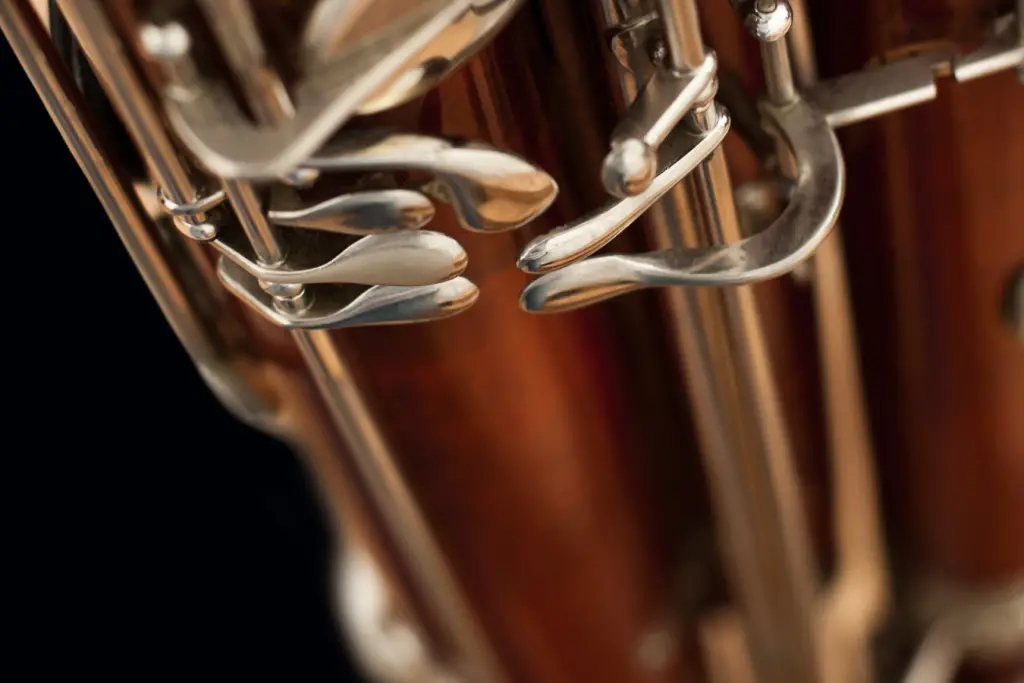The bassoon is celebrated for its rich, versatile tone and wide range, making it a cornerstone of woodwind sections in orchestras and ensembles. This unique instrument spans a considerable spectrum of notes, capable of producing deep, resonant lows and surprisingly light, agile highs. In this article, we’ll explore the bassoon’s range, how it achieves its distinctive sound, and its role across various musical genres.
The Range of the Bassoon
The bassoon’s range covers roughly three and a half octaves, from B♭1 (the first B-flat below the bass clef) to E5 (above the treble clef). This impressive span allows the instrument to perform a wide variety of musical roles, from providing a solid harmonic foundation to playing intricate melodic lines.
- Low Range (B♭1 to F2): Known for its deep, resonant quality, this range is often used for dramatic, grounding effects.
- Middle Range (G2 to G3): A balanced and versatile section of the range, often used for lyrical and melodic passages.
- High Range (A3 to E5): Bright and expressive, this range adds agility and character, often featured in solos and virtuosic passages.
Anatomy of the Bassoon’s Range
1. Low Notes: The Foundation of the Bassoon
The bassoon’s low range, particularly the B♭1, is one of its defining characteristics. This range is produced by the long bore of the instrument and the player’s ability to control air pressure and embouchure.
- Characteristics:
- Deep and sonorous.
- Often used in orchestral works to create a sense of gravitas.
- Notable Uses:
- In Tchaikovsky’s 1812 Overture, the bassoon’s low notes reinforce the dramatic tension.
- Frequently employed in film scores to convey mystery or foreboding.
2. Middle Range: The Lyrical Voice
The middle range is where the bassoon’s voice becomes more melodic and expressive.
- Characteristics:
- Warm and smooth.
- Ideal for lyrical solos and blending with other instruments.
- Notable Uses:
- In Mozart’s Bassoon Concerto in B-flat Major, the middle range shines during the second movement.
- Perfect for chamber music, offering harmonic richness.
3. High Notes: The Agile Performer
While the bassoon’s high range is less commonly featured, it adds brilliance and flair when used effectively.
- Characteristics:
- Bright and clear.
- Requires precise control of embouchure and breath support.
- Notable Uses:
- Featured prominently in Stravinsky’s The Rite of Spring.
- Adds a playful or whimsical touch in lighter compositions.
Factors Affecting the Bassoon’s Range
1. Reed Quality and Design
The reed plays a crucial role in determining the bassoon’s sound and range.
- Well-crafted reeds: Allow players to reach the extremes of the bassoon’s range with ease.
- Poor-quality reeds: Limit flexibility and can make high notes difficult to achieve.
2. Player Technique
A skilled player can extend the bassoon’s natural range through:
- Controlled Embouchure: Precise shaping of the lips to maintain a steady tone.
- Breath Support: Proper diaphragm engagement for consistent airflow.
- Fingering Techniques: Mastery of advanced fingerings for difficult passages.
3. Instrument Quality
Higher-quality bassoons provide better intonation and ease of play across the entire range.
- Student Models: Typically focus on the core range, with some limitations on the highest notes.
- Professional Models: Designed to optimize tone and accessibility throughout the instrument’s full range.
Expanding the Bassoon’s Range
While the standard range is impressive, some bassoonists push the boundaries through advanced techniques:
1. Multiphonics
- Producing multiple pitches simultaneously by manipulating fingerings and embouchure.
- Often used in contemporary and experimental music.
2. Altissimo Register
- Extending beyond E5 into the altissimo range.
- Requires advanced control and is used sparingly in compositions.
3. Overblowing Techniques
- Achieved by increasing air pressure and adjusting embouchure to produce higher harmonics.
Comparisons with Other Woodwinds
1. Bassoon vs. Clarinet
- Range: The clarinet has a wider range, extending higher than the bassoon.
- Tone: The bassoon’s tone is warmer and more robust in the low register, while the clarinet excels in brightness and agility.
2. Bassoon vs. Oboe
- Range: The oboe’s range is more limited compared to the bassoon.
- Role: The oboe often carries melodies, while the bassoon supports harmony and texture.
3. Bassoon vs. Saxophone
- Range: The bassoon and saxophone have similar ranges, but the saxophone’s timbre is more modern and brassy.
- Versatility: The bassoon is more common in classical settings, while the saxophone dominates jazz and pop genres.
Famous Bassoon Excerpts Highlighting Range
The bassoon’s range is showcased in numerous orchestral and solo works:
- Tchaikovsky’s Nutcracker Suite: The bassoon’s low notes set a mysterious tone in “Dance of the Sugar Plum Fairy.”
- Beethoven’s Symphony No. 4: Features lyrical passages in the middle range.
- Stravinsky’s The Rite of Spring: A striking opening solo that demands mastery of the high range.
Tips for Mastering the Bassoon’s Range
- Practice Long Tones: Focus on maintaining a steady pitch across the full range.
- Reed Experimentation: Try different reed shapes and materials to find the best fit for your playing style.
- Seek Guidance: Work with a teacher to refine advanced techniques.
- Explore Repertoire: Challenge yourself with compositions that span the instrument’s full range.
Conclusion
The bassoon’s impressive range is one of its most remarkable features, allowing it to play diverse roles in classical, contemporary, and experimental music. From its resonant low notes to its agile high register, the bassoon’s capabilities are a testament to its unique design and the skill of its players. Understanding and mastering the instrument’s range not only enhances technical ability but also opens the door to expressing its full artistic potential.

